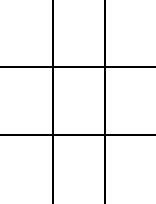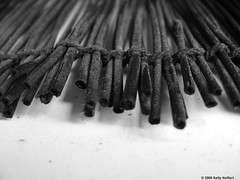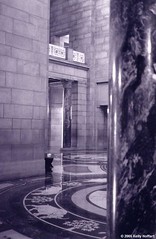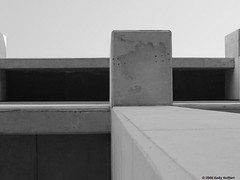Assignment 1: Basic Composition and the Rule of Thirds
For the first assignment, let's focus on basic composition. For this assignment, any camera will do. However, an SLR camera or a digital camera with an LCD screen are preferable (because you can see exactly what you're going to get).
You will also learn more if you work in black and white for this assignment. And, try to remember, at least for this assignment, that the picture isn't "of" anything. It's just a picture with pretty shapes and shades.
For this assignment, there will be absolutely no cropping. We're going to do what they call "cropping in camera," which means that everything you see in your viewfinder (or LCD screen) will add to the picture. This is all you need to know to complete this assignment. Read on if you want to complete it well.
The Rule of Thirds
The rule of thirds is the most basic composition rule in photography. It means, essentially, that you should imagine lines going through the frame at 1/3 and 2/3 of the way through. This can be horizontally, vertically, or both.


Just imagine these crosshairs on your viewfinder, and try to line things up with the lines or fill up each successive section with a different, interesting thing. Often, it's better to fill up just 1/3 of the image with one thing and 2/3 with something else. Believe me, your pictures will be three times as good just from following this advice.
Now, because a picture is worth a thousand words, some examples from my work:

This is a photo that follows the rule in a purely horizontal way. Note how the upper 2/3 of the image is dark and the bottom 1/3 is light. Remember, the picture isn't "of" anything. It's just a picture with nice lines and shading.

This picture gives you an example of how the rule of thirds can work vertically. The wall on the left is 1/3, the column on the right is 1/3, and the more open space in the middle is another 1/3.

And finally, this picture is an example of how you can mix both vertical and horizontal lines. The picture is split into three different sections from top to bottom, but it also uses a strong vertical third (here, it's almost 1/2, but try not to push it this far until you get some more experience).
Now, go out, shoot, and share!
(When you complete the assignment, why don't you share it with the group's Flickr pool?)
Next Assignment: Light and Shadow

6 Comments:
You have a slightly scary tone but I do like your photos!!
Hmm, that profile picture is a bit scary. I don't think I'll need it on this site. I hope the words I type aren't scary!
Thanks for the info. I will check back from time to time. I need all the insight I can get
I was browsing flickr groups today, and found this... In the first photo, of the reed mat, you state the obvious, the top 2/3 is dark, bottom 1/3 is light. What you didn't state was the additional interest of having the connecting line of the mat following the top 1/3 line. My eyes get drawn immediately to that line because of the placement...
Great eye, anonymous! Yes, I did notice that, but you make an excellent point that's worth noting. Maybe some time when I post examples I won't give any explanation as to why I think they're good examples, and just wait for people to comment on them.
Every photographer should learn Rule of Thirds. I have a photography blog where I explained about Sunny 16 Rule.
http://trickytechtunes.blogspot.com/2015/11/sunny-16-rule-photography-without-light.html
I think this will be helpful for the readers.
Post a Comment
<< Home